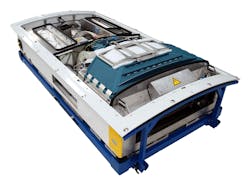During an expert discussion organized by the UBA, Germany’s Federal Environmental Agency, on January 25, 2018 in Berlin, Deutsche Bahn (DB) and Liebherr-Transportation Systems presented the results of a joint project comparing Liebherr's environmentally friendly, air cycle air conditioning system with a traditional vapor cycle system operating with the refrigerant R134a.
Liebherr-Transportation Systems has successfully completed a project examining air conditioning in public transport on behalf of the UBA (Dessau-Rosslau, Germany) as part of the Environmental Research Plan of the Federal Ministry for the Environment, Nature Conservation, Building and Nuclear Safety. The aim was to test, measure and assess air conditioning systems operating with only natural coolants for sustainably cooling and heating public transport.
Testing in real operating conditions
Once individual cars had been converted at the DB plant in Nuremberg, a train from the ICE-3 fleet (type 403, first series) with air cycle air conditioning systems was tested in passenger service from the end of June 2015. The Liebherr-Transportation Systems team had installed additional sensors and measuring systems for this test in order to collect extensive operating data for a period of two years and thereby allow detailed analysis of the systems. Their aim was to calculate the system's energy consumption over its entire life cycle using data collected in real operating conditions and through all seasons. On this basis, it was also possible to determine whether air conditioning that runs on a natural coolant, air, is competitive and comparable with traditional air conditioning systems.
Among other things, there was a focus on the energy efficiency demonstrated by Liebherr systems in daily passenger service operation. The test train was kept under careful observation, particularly during the hot summer months of July and August. Together with the UBA and DB, the Liebherr team thoroughly analyzed and assessed the data which was collected.
Three climate zones were under observation: cool (Braunlage), moderate (Kassel) and warm (Mannheim). On average the analysis of primary annual energy requirements for comfort cooling showed that an air cycle system with a reduced-pressure process (ICE-3) consumed 28 percent less power during the test than a vapor cycle system with speed-controlled compressor and the option of counter-heating (ICE-T). Analysis of secondary energy requirements (for traction) resulting from the pulse resistance of the air taken in by the air conditioning system yielded a reduction of more than 50 percent compared to the vapor cycle system. This further expands the advantages of air cycle technology. Overall, when it came to annual energy consumption in realistic operating conditions, air cycle technology showed a clear advantage. Reduced energy consumption had an immediate effect in lowering the environmental impact of energy provision (depending on the power mix) and in considerably reducing operating costs.
The UBA supported the project involving the ICE 3 because, from an environmental point of view, the air cycle technology offers advantages over traditional vapor cycle systems with fluorinated refrigerants.
Environmentally friendly technology
The maintenance-friendly air cycle air conditioning system was developed by Liebherr-Transportation Systems. Air cycle technology is environmentally friendly because it requires no synthetic refrigerants with their associated greenhouse effect. Instead, cooling is performed exclusively with natural ambient air. This air is first conducted through an open loop by a cooling turbine running at high speeds. The cooling turbine is a compact component consisting of a turbine stage, a compressor stage and an electrical motor, all of which are connected by a common shared shaft. First the air is depressurized to below atmospheric pressure at the turbine stage, which cools it considerably. This cold air then passes through a heat exchanger, where it absorbs the heat from the air streaming into the passenger compartment. During the last stage in the open circuit, the depressurized air is conducted through the compressor stage of the cooling turbine and compressed back to atmospheric pressure. During this process the air heats up significantly. That means the surroundings can be used highly effectively as a heat exchanger with 100% effectiveness. The entire air cycle air conditioning system comprises only a few components and is therefore very easy to maintain.
Compared to conventional refrigerants such as R134a, air has many advantages: it does not need to be produced, as it exists already and is available everywhere. For this reason it requires no expensive storage and does not need to be disposed of after use. Potential leaks are not critical, because air has no negative effects on the environment and poses no potential risks. While employees working in air conditioning system production and on rail operation need training in handling refrigerants, no special training is required for handling air.
The air cycle air conditioning systems from Liebherr-Transportation Systems have performed exceptionally well in DB's daily passenger business. Their main features are low operating costs and robustness, as they continue to operate effectively even when outside temperatures are very high in summer. In addition, the energy consumption of air cycle air conditioning systems is lower than that of conventional systems.
The encouraging results of the field data analysis are not just a confirmation for Liebherr; they are also driving factor to continue developing environmentally friendly air conditioning for rail vehicles in a broad range of applications. With its innovative technology for air cycle air conditioning, the company is making an important contribution towards sustainable passenger transportation.



